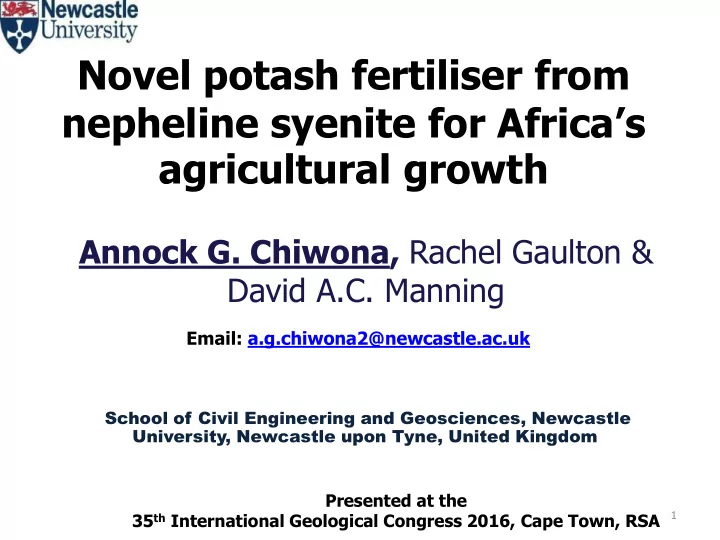

Novel potash fertiliser from nepheline syenite for Africa’s agricultural growth Annock G. Chiwona, Rachel Gaulton & David A.C. Manning Email: a.g.chiwona2@newcastle.ac.uk School of Civil Engineering and Geosciences, Newcastle University, Newcastle upon Tyne, United Kingdom Presented at the 35 th International Geological Congress 2016, Cape Town, RSA 1
Outline Research background Africa population vs agriculture dynamics Current Project feasibility in Africa Study’s Goal and approach Initial results Achievements so far Future work Conclusion 2
Research background (Source: Manning, 2015) With global population projected to 9billion and 2billion in Africa by 2040, food insecurity likely major problem (Manning, 2015; Sheldrick, Syers & Lingard, 2002) 3
Africa population-agriculture dynamics • Status of agricultural industry of Africa has not been as expected for many years. • Between 1960-1980s only 2% p.a growth in Agriculture sector (1.85% in crop yields against 3% annual population growth (Larson & Frisvold, 1996). Significant decline in per capita growth about 18% (1969 – 1987) and 10% decline in 1996. Nutrient loss due to intensive farming in sub-Saharan about 22kg N, 2.5 kg P and 15 kg of K per hectare each year in last 30 years (Keeble, 2012). • Intensification of crop production by increasing soil fertility through fertiliser use is probably most viable option to achieve food security There has been more soil mining than nutrient replenishment 4
What this means for Africa Malawi K nutrients soil depletion in African countries, (data from Sheldrick et al., 2002). • Africa, with 15% of global population uses just 1.5% of world's K fertiliser • Great need for alternative potash sources hence my present research 5
Project feasibility in Africa Literature shows Malawi’s Nepheline syenite rocks have similar geochemistry to some areas already tested for fertiliser use. 6
Study’s Goal and approach Main goal: To assess potential of nepheline syenites (Nsy) from rift tectonics, with initial focus on Malawi, as alternative K fertiliser sources. 7
Materials and Methods (a) (b) Key data include ASTER and SRTM imagery, Malawi’s airborne • geophysical radiometric data to delineate potential areas 8
Spectral response of nepheline syenite Shows distinct spectral curves in TIR region of electromagnetic spectrum 9
Initial results 10 Overlayed with alkaline intrusion locations (Woolley, 2001).
11 Overlayed with alkaline intrusion locations (Woolley, 2001).
12
Achievements so far • Identified potential areas of interest from remote sensing and gamma ray data. • Ground truthing is in progress – Hand-held gamma ray spectrometry – Most areas surveyed agree with results from remote sensing and airborne geophysical survey results 13
Future work • Complete ground truthing of selected potential areas – Combined with spectral analyses of rocks and soils • Conduct petro-geochemical analyses • Conduct K release studies for nepheline syenite • Conduct plant growth experiments 14
Conclusion • There is greater need to intensify use of fertiliser for food security and sustainable agricultural sector growth in Africa. • Agro-geology offers new opportunities for the fertiliser industry. • Nepheline syenites from the EARS are promising for novel, low cost and easy to use silicate K alternatives for Africa. • Great appreciation to Newcastle University, Society for Economic Geologists, Terrativa and Malawi Government for the financial and techinical support to the research. 15
Thank you very much Email: a.g.chiwona2@newcastle.ac.uk 16
References Keeble F. 2012. "Food for thought", Nature, vol. 483, no. 7391, pp. 510. • Larson, B. A. and G. B. Frisvold 1996. "Fertilizers to support agricultural • development in sub-Saharan Africa: What is needed and why." Food Policy, vol. 21 no. 6.pp.509-525. Manning, D. A. C. 2015. "How will minerals feed the world in 2050?" • Proceedings of the Geologists' Association, vol 126 no. 1, pp. 14-17. Manning, D. A. C. 2010. "Mineral sources of potassium for plant • nutrition. A review." Agronomy for Sustainable Development, vol. 30 no. 2, pp. 281-294. Sheldrick, W. and J. Lingard 2004. "The use of nutrient audits to • determine nutrient balances in Africa." Food Policy, vol. 29, no.1, pp.61- 98. Sheldrick, W., et al. 2002. "A conceptual model for conducting nutrient • audits at national, regional, and global scales." Nutrient Cycling in Agroecosystems, Vol 62 , no.1 pp.61-72. Woolley, A.R. (2001). Alkaline Rocks and Carbonatites of the World. Part • 3: Africa. London: Bath. 17
Recommend
More recommend